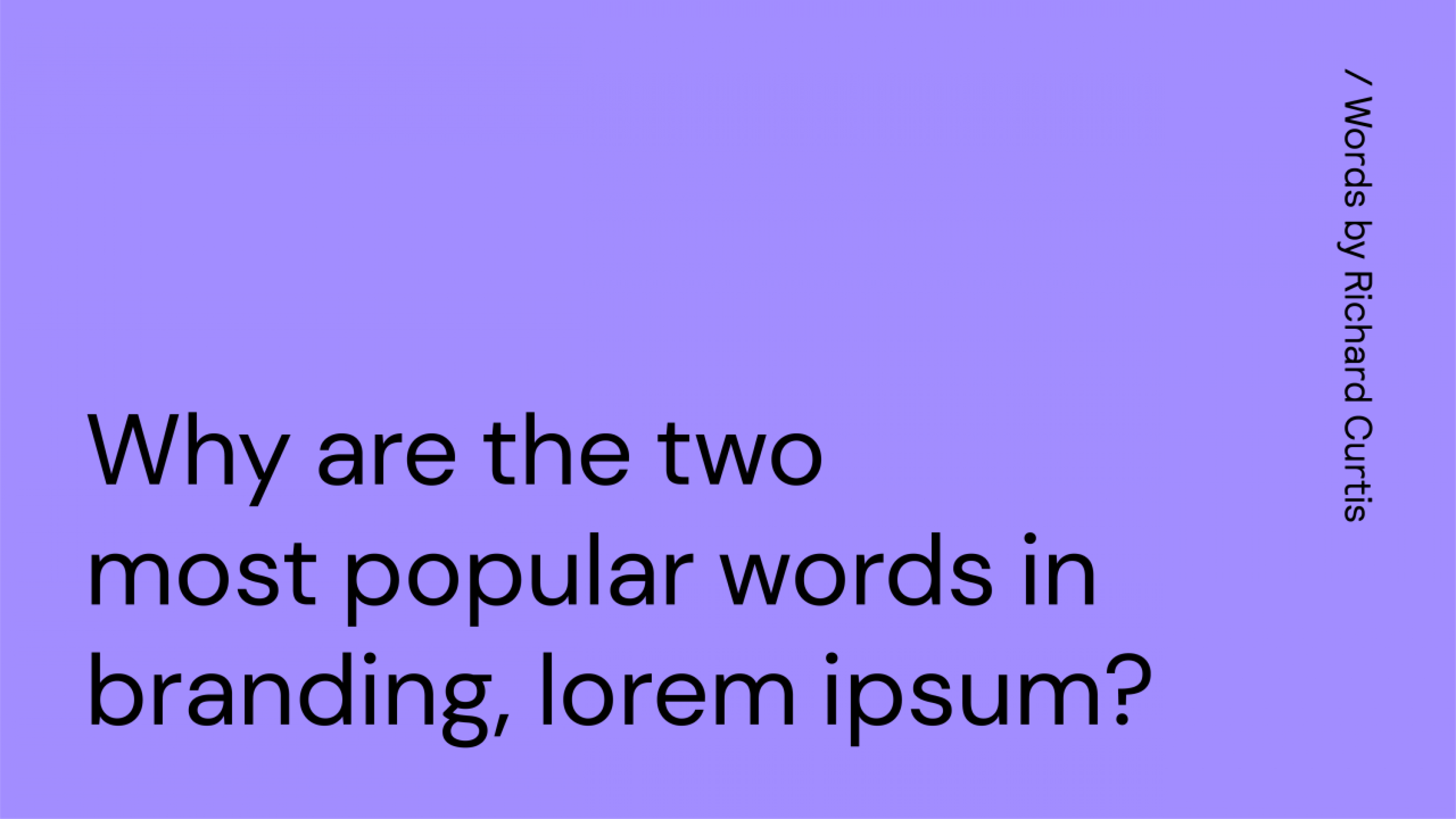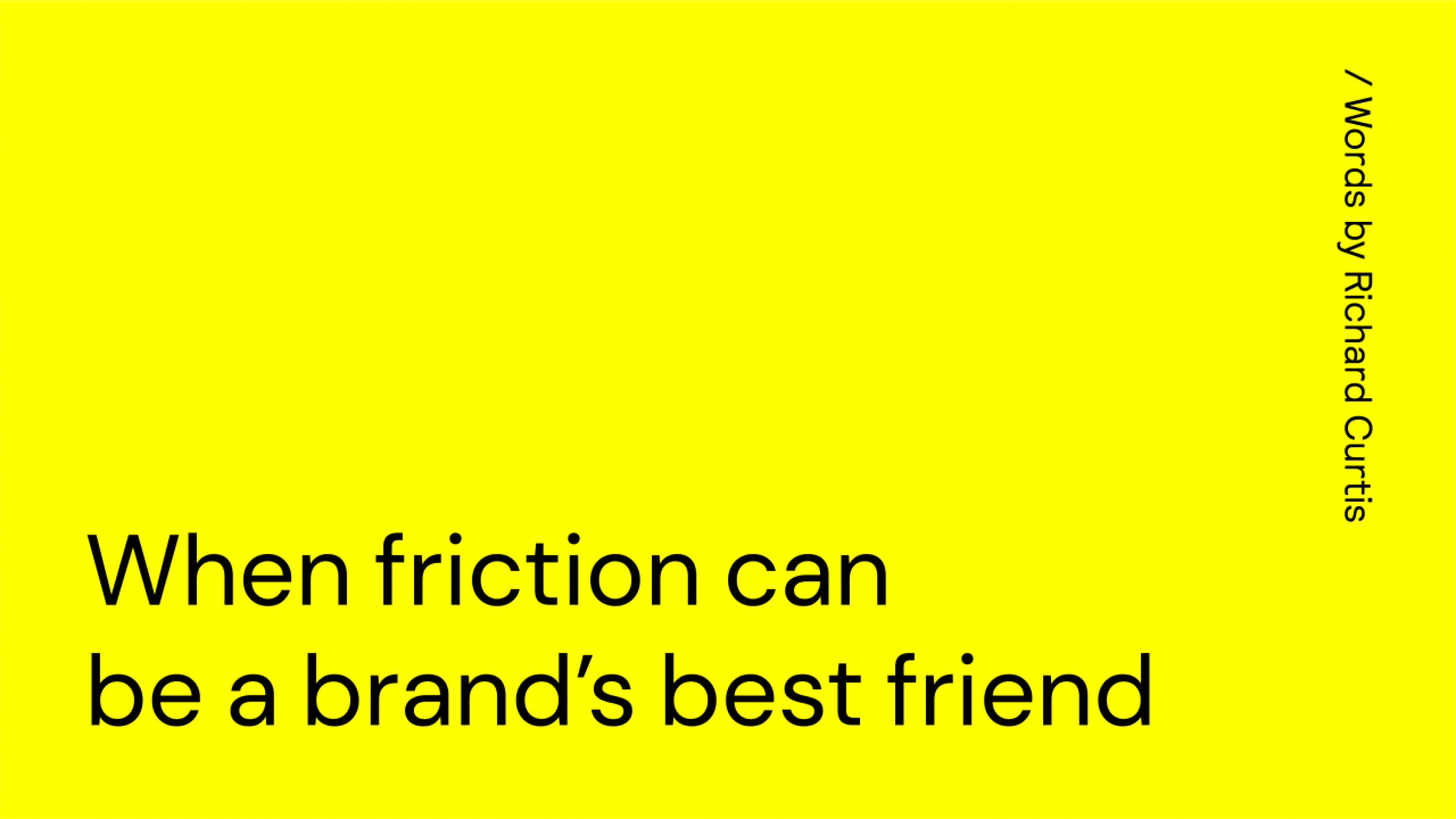

Why are the two most popular words in branding, lorem ipsum?
If the mark of a civilised society is language, then many brands are still struggling through the dark ages.
Weeks and months are typically invested in the design of a brand’s visual identity, but all too often just a matter of days are spent on devising a brand’s voice. Just a couple of pages buried in the middle of the brand guidelines document – perhaps a paragraph or two about writing in the first person, using the active voice and some clichéd terms to avoid.
As for the rest of the brand guidelines, page after page bursts with examples of every conceivable application of the brand, from advertising billboards to tote bags. Each and every one is demonstrated artfully with the brand’s visual identity expressed to full effect, all of which only serve to make the headlines all the more jarring and meaningless.
Lorem ipsum dolor sit amet, consectetur adipiscing elit.
It is indeed meaningless – a jumbled version of Cicero’s musings on life in Roman times and used for centuries for its combination of letters and the spacing between them to display the features of a typeface at its best. But sadly, your brand’s voice at its worst.
What’s lost on many organisations is the fact that your brand’s voice is invariably the one and only tool used by every single person in your organisation, irrespective of their role and responsibility. Language is behavioural in so far it shapes how people respond, whether they might feel engaged or enraged at any particular point in the process. It’s invaluable for an organisation to find its voice and strike up a meaningful conversation with its customers. Lorem ipsum is the equivalent of putting your hand over your mouth and staring awkwardly at your shoes as you mumble your way through the features and benefits of your product or service.
Hello, how are you?
Whenever we greet someone, it’s second nature to ask how they’re feeling. For all the media press and pixels dedicated to ‘purpose’ – why? – we instinctively start with the ‘how’. Because it’s often ‘how’ we make people feel that makes the pivotal difference.
So how do you want your words to make people feel?
Inspired? When reading your customer stories and case studies to understand if you feel like the right product or partner for them.
Informed? When delving into product or service features and wanting to learn more about the benefits of one over another before they feel confident enough to make a purchase decision.
Instructed? When looking for guidance and help, whether to solve a problem or pick up a new skill and feel supported every step of the way.
Don’t just choose your words carefully, choose them creatively in order to evoke both the right emotional and behavioural response.
What do you expect me to say?
An important first step is to understand how language is used and for what purpose – in terms of what you need to say, when and how you need to say it. If you’re to create your brand’s voice as a brand experience tool for your people, then you need to make sure it’s as useful as possible.
Your brand will need to speak with one voice but also have the versatility to carry many different types of conversations across a range of touchpoints, whether digital or personal. By mapping your brand’s voice with this breadth and depth, language can become a versatile tool for all the nuts and bolts that hold the customer experience together.
One brand that dials up the versatility but never loses its focus is Mailchimp. The martech vendor has even going so far as to include a TLDR section in its content style guide. Whether writing for different types of people or in different formats, Mailchimp uses practical advice and examples that guides people to embrace the brand beyond the basics of grammar, which is where too many brand language guidelines start and stop.
Another is Slack, a brand that incorporates a three-tier system for how the brand sounds. Firstly, its brand voice; secondly, the spectrum across which it modulates its brand voice throughout the user journey; thirdly, copy principles to guide writing style. It’s that second tier that is pivotal, quite literally, so Slack can effectively adapt its brand’s voice to speak directly to the specific customer need at any given moment in their user journey.
What’s more, it’s not simply a question of making generic, feel-good statements or overlaying a corporate-friendly tone of voice onto the experience at large. On the contrary, the more ‘concrete’ your language, the better, by using language that is more specific, tangible and vivid. Research, How Concrete Language Shapes Customer Satisfaction by Grant Packard and Jonah Berger in the Journal of Consumer Research 2021 has shown this more ‘concrete’ language signals attention and understanding in ways that make customers feel that they are actually being listened to. Consequently, it leads directly to increased customer satisfaction and even an uplift in sales.
Familiarity breeds fluency
Getting your teams excited about the power of language is only half the story if you don’t equip them with the training to use it. And getting to know your brand’s voice is an immersive experience. In other words, you can’t simply read about it, you need hands-on writing, training and support.
For example, want to exercise some focus or even efficiency in your brand’s voice? Have your teams explore what it might mean to keep things simple by having them rewrite newsletters and other communications as tweets (and using the original 140-character limit for maximum effect).
Need to make sure your brand understands your customers? Find a pair of their shoes that might ‘fit’ your customer – whether on the Internet or on someone’s feet – and use them to imagine who exactly might be wearing them. Start by describing the shoes, then the person, and you’ll find yourself creating a real-world customer persona to whom you can write directly, each and every time you communicate your brand.
Or, keen to surface what makes your brand and voice distinctive? Take your competitors’ website or piece of communication and rewrite it using your own brand. How would it sound different? What would you change, and why? Every language choice you make will help hone your brand to be yours, truly.
By helping your organisation to spell out your brand’s language, you can unlock myriad possibilities for more distinctive and more meaningful communications and interactions – while they say a picture paints a thousand words, a word can start a million stories. Death to lorem ipsum, let your brand’s voice be heard.
This article was first published by CMO.
Related articles

When friction can be a brand’s best friend
The latest in the series of CMO guest writer contributions

FutureBrand Australia appoint Brand Language Director
Thebridge will be responsible for leading the strategic and creative development of brand language and tone of voice programmes for FutureBrand’s clients.
